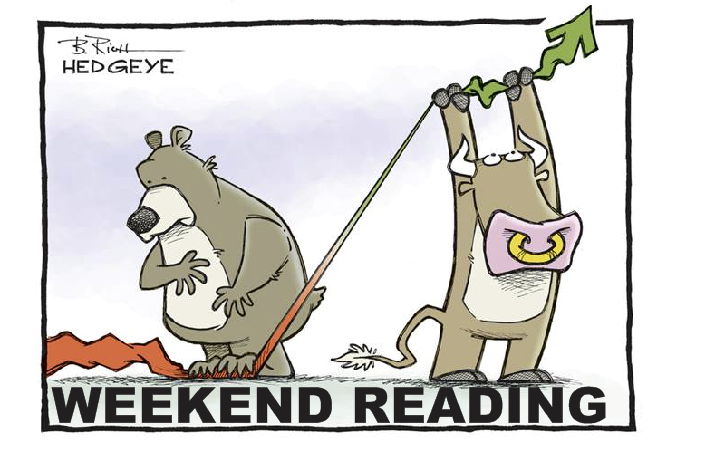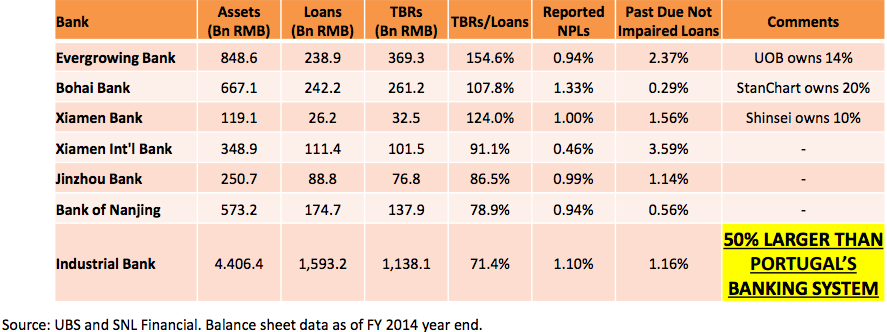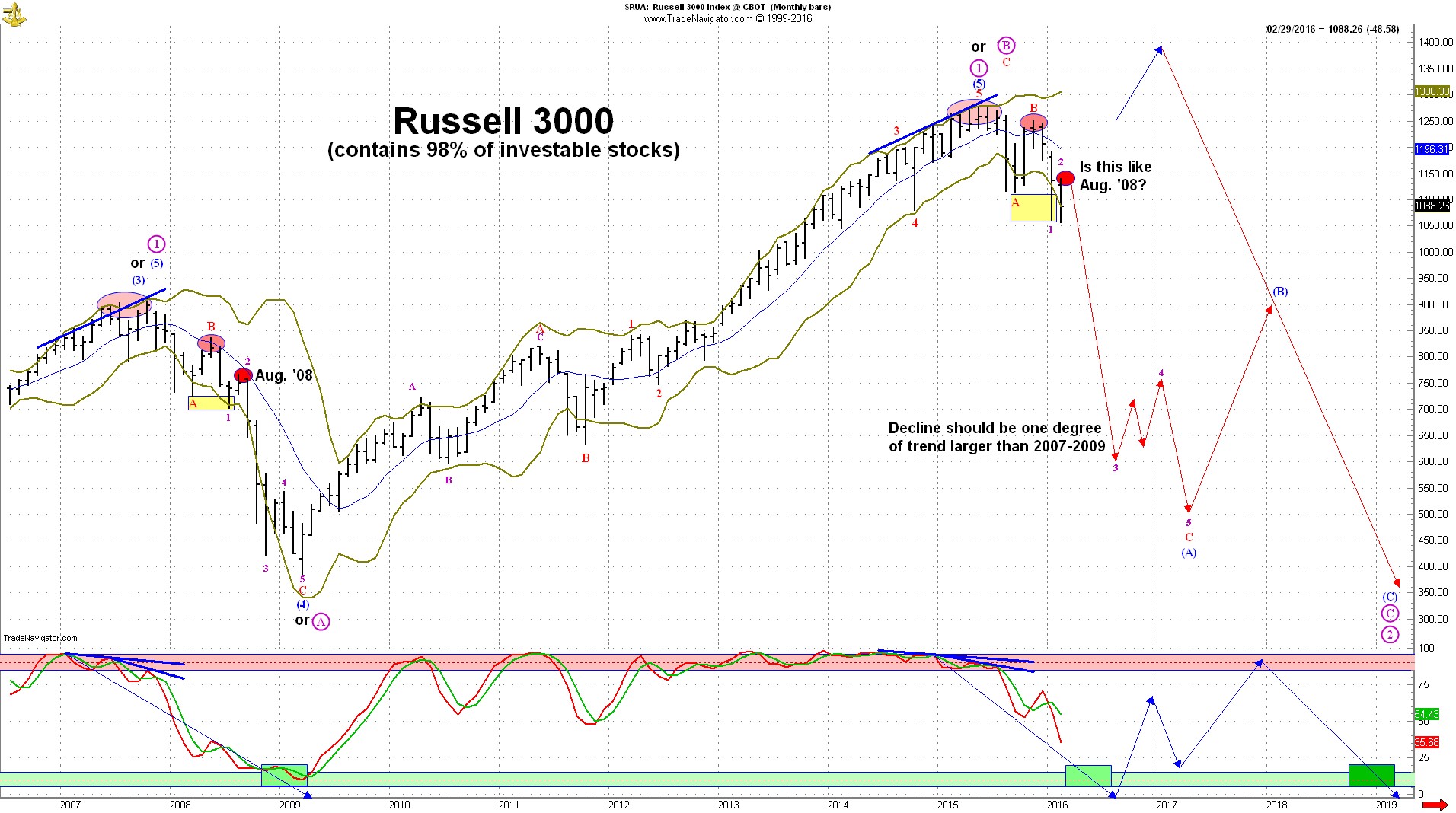[David Stockman’s Note: Next Wednesday, I’m streaming an urgent, live video broadcast from my living room in Aspen, CO. I believe the most popular investment of the 21st century is about to implode. The collapse of this $3 trillion bubble could be the “final nail: in your retirement if you’re unprepared. But, if you invest in a discreet alternative investment right now your savings could be spared… and you could actually make up to 300% by July. That’s why I’m hosting this live video training from my home. I’ll lay out all of these details and more for you. All you need to do is RSVP right here before your spot is taken. There’s nothing to buy in order to get access — it’s free.]
That didn’t take much. After a three-day rally, the media is back into “bullish” mode suggesting the bottom is likely in and by the end of this year, it’s all going to be just fine.
Unfortunately, history suggests that after such a long unabated expansion risks are substantially higher than it has been previously. Furthermore, as I have repeated often in these missives, in an economy that is driven primarily based on consumption, and such consumption is already weak, it doesn’t take much to “flip the switch.”
Believe it or not, this was a point make by former bull Joseph LaVorgna, Chief Economist for Deutsche Bank, now turned…da..da..dum…“bear.” (Lord help us, hell hath frozen over.)
This week’s reading list in a continuation of thoughts on the current state of the financial markets, economy and the Fed. Is the recent correction now over setting the stage for the bull to begin its next charge? Or, is the recent rally just a trap drawing unwitting investors into the next sell off? No one knows for sure, but what you decide next could have potentially serious ramifications.
1) Bearish Sentiment A Cocktail For Rallies by Doug Kass via Real Clear Markets
“As I noted both four weeks ago and again late last week, numerous precedents and positive technical divergences have led to our current sharp rally, including the fact that:
Despite the S&P 500 and Dow Jones Industrial Average recently hitting fresh lows, only about 50% as many New York Stock Exchange-listed companies hit new 52-week lows this month as did so in January.
The percentage of stocks trading above their 50- and 200-day moving averages was higher at the recent low than it was at the market’s January low.
The McClellan Oscillator and Summation Index recently held at higher oversold levels.
Conversely, the market’s recent leaders have gone on the defensive and become laggards. But as I’ve previously pointed out, leadership changes often accompany a weak overall market — so we have to stay alert.”
But Also Read:The Curious Case Of Surging Transportsby Mark Hulbert via MarketWatch
But Read: Bert Dohmen Is Uber-Bearishby Financial Sense
2) Odds Of A Recession At 33% By Next Year by Larry Summers via The Washington Post
“I would put the odds of a U.S. recession at about 1/3 over the next year and at over ½ over the next 2 years. There is a substantial chance that widening credit spreads, a strengthening dollar as Europe and Japan plunge more deeply into the world of negative rates, and lower inflation expectations will be tightening financial conditions even as recession looms. And while there is certainly scope for quantitative easing, for forward guidance and possibly for negative rates, it is very unlikely that the Federal Reserve can take steps that are nearly the functional equivalent of 400 basis point cut in Fed funds that is normally necessary to respond to an incipient recession.”
But Also Read:The 4-Horseman Of The Economy Are Here by Constantin Gurdgiev via True Economics
3) Kyle Bass: A Ticking Bomb In China by Julia La Roche via Business Insider
“China’s banking system has grown from under $3 trillion to over $34.5 trillion in assets over the last 10 years alone. No credit system in history has ever attempted this rate of growth. There is no precedent.
What does this mean for Chinese banks? There is a bad answer and a worse answer. The bad answer is that Chinese bank capital – the equity buffer – is significantly overstated. A TBR requires much less capital to be set aside (only 2.5c as opposed to 11c for an on-balance sheet loan) at the time of origination (anyone thinking Fannie and Freddie?). Adjusting reported bank capital ratios for this effect changes reasonable 8-9% Core Tier 1 capital ratios (CT1) to undercapitalized 5-6% levels.
Now, the worse news. TBRs are one of the biggest ticking time bombs in the Chinese banking system because they have been used to hide loan losses.“
Also Read: The China Delusionby Rob Johnson via Project Syndicate
4) Central Banks & The Ongoing Dispute
- Negative Rates Are A Failure by Ambrose Evans-Pritchard via The Telegraph
- Yes, NIRP Was A Bad Ideaby Izabella Kaminska via FT AlphaVille
- NIRP Doomed To Failureby Frank Hollenbeck via The Mises Institute
- Central Banks Face Credibility Testby John Plender via FT.com
- Japan Near Ending Of Stimulusby Jeffrey Snider via Alhambra Partners
- Central Banks Face New Worldby Caroline Baum via E21
- Central Banks Are Cluelessby Alanna Petroff via CNN Money
- Negative Rates, Deficits & Defaultsby Reuven Brenner via Asia Times
5) It’s August 2008 All Over Againby Ken Goldberg via The Street
“The stock market’s path for the next month or two is likely to take its toll on both bulls and bears. This is because of how the market tends to “frack” its way through major peaks and troughs, as some indices peak earlier than others, while others tend to trough earlier than others. If you know which index is leading the others, the solution is simple. Once the leader shows its hand, take the appropriate action in the followers and wait for them to catch up, as the profits should be close behind, right? Maybe. Unless humans are involved. We tend to use coping mechanisms that limit our ability to see what the markets are showing us. That historically results in situations where the herd becomes bullish at major tops and bearish at major bottoms.”
But Also Read: An Unambiguous Buy Signal by Jeff Cox via CNBC
And Read: Bear Market Ralliesby Urban Camel via Financial Sense
THE USUAL SUSPECTS
- Fed Bullard – Unwise To Hike Rates, More QEby Tyler Durden via Zero Hedge
- 21 Numbers On The Global Economyby Michael Snyder via Economic Collapse
- Foundation Of Housing Still Missingby Mark Hanson via MHanson.com
- The Case For Global Tightening by Sober Look
- Warning With A Capital “W” by John Hussman via Hussman Funds
- Art & Shipping Send Warningby Jesse Felder via The Felder Report
- Transports Flagging A Warningvia Dana Lyons via Tumblr
- Flipping Volatility Regimesby Salil Mehta via Statistical Ideas
“Investors are condemned by almost mathematical law to lose” – Ben Graham
Questions, comments, suggestions – please email me.
Lance Roberts
Lance Roberts is a Chief Portfolio Strategist/Economist for Clarity Financial. He is also the host of “The Lance Roberts Show” and Chief Editor of the “Real Investment Advice” website and author of “Real Investment Daily” blog and “Real Investment Report”. Follow Lance on Facebook, Twitter, and Linked-In






